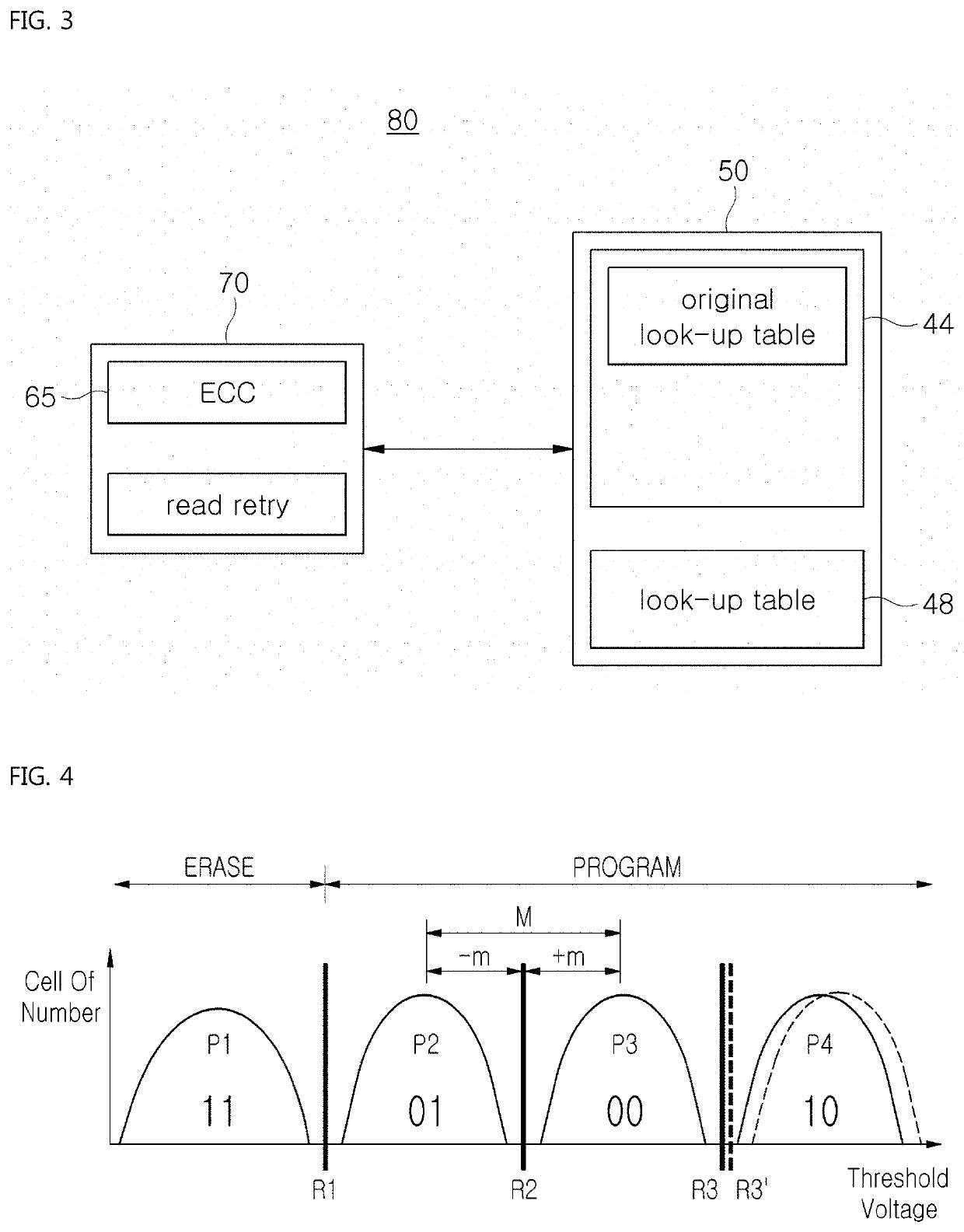Method of operating storage device
- Summary
- Abstract
- Description
- Claims
- Application Information
AI Technical Summary
Benefits of technology
Problems solved by technology
Method used
Image
Examples
first embodiment
[0044]FIGS. 4 and 5 illustrate a read retry algorithm according to the present invention which is to be embedded in the storage device of FIG. 3.
[0045]Referring to FIGS. 4 and 5, the read retry algorithm adjusts the default read reference voltages R1, R2, and R3. The adjustment of the default read reference voltages R1, R2, and R3 is performed in accordance with actual use conditions of the storage device 80 on the basis of a threshold voltage distribution graph of FIG. 4.
[0046]The adjustment of the default read reference voltages can be performed in accordance with use conditions of the storage device 80, for example, particularly taking into account: pre-treating stress generated to the NAND flash memory 50 during a thermal endurance test performed by the manufacturer of the NAND flash memory 50 after the NAND flash memory 50 is manufactured; heat stress generated to the NAND flash memory 50 while the NAND flash memory 50 is mounted in the storage device 80 using a surface mountin...
second embodiment
[0055]FIGS. 6 to 8 illustrate a read retry algorithm according to the invention, to be used in the storage device of FIG. 3.
[0056]Referring to FIGS. 6 to 8, the read retry algorithm is configured to adjust the default read reference voltages R1, R2, and R3 (refer to FIG. 4). The adjustment of each of the default read reference voltages R1, R2, and R3 is performed by the controller 70 on the basis of a threshold voltage distribution graph (refer to FIG. 4). The adjustment is performed according to a read error margin M between two adjacent threshold voltage states P1 and P2, or P2 and P3, or P3 and P4.
[0057]The adjustment of the default read reference voltage for each threshold voltage stat is performed according to a read error margin M between two adjacent threshold voltage states P1 and P2, P2 and P3, or P3 and P4, and a retention degradation stage of the NAND flash memory 50, which is determined on the basis of the elapsed time after the NAND flash memory 50 is manufactured by th...
third embodiment
[0064]FIGS. 9 to 12 illustrate a read retry algorithm according to the present invention, which is to be used in the storage device of FIG. 3, wherein FIG. 9 is a schematic cross-sectional view, FIG. 10 is a perspective view, FIG. 11 is a graph, and FIG. 12 is a table.
[0065]Referring to FIGS. 9 to 12, the read retry algorithm is configured to adjust the positions (i.e., values) of the default read reference voltages (R1, R2, and R3 of FIG. 4). The adjustment of the default read reference voltages is performed by the controller 70. The adjustment is performed according to the read error margin M between the two adjacent threshold voltage states P1 and P2, or P2 and P3, or P3 and P4, and to the location of each word line group of the NAND flash memory 50.
[0066]The adjustment of the default read reference voltages is performed according to the retention degradation stage of the NAND flash memory 50 mounted in the storage device 80 by taking into account the elapsed time after the NAND ...
PUM
 Login to View More
Login to View More Abstract
Description
Claims
Application Information
 Login to View More
Login to View More - R&D
- Intellectual Property
- Life Sciences
- Materials
- Tech Scout
- Unparalleled Data Quality
- Higher Quality Content
- 60% Fewer Hallucinations
Browse by: Latest US Patents, China's latest patents, Technical Efficacy Thesaurus, Application Domain, Technology Topic, Popular Technical Reports.
© 2025 PatSnap. All rights reserved.Legal|Privacy policy|Modern Slavery Act Transparency Statement|Sitemap|About US| Contact US: help@patsnap.com



